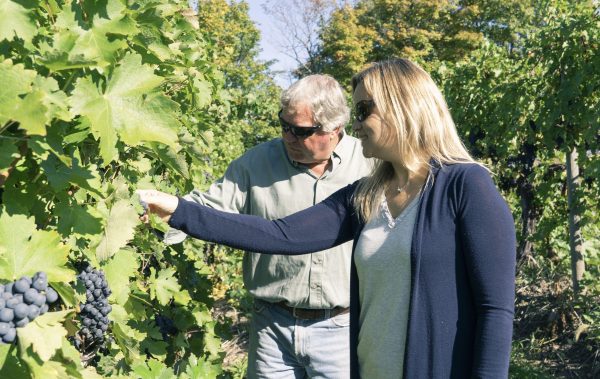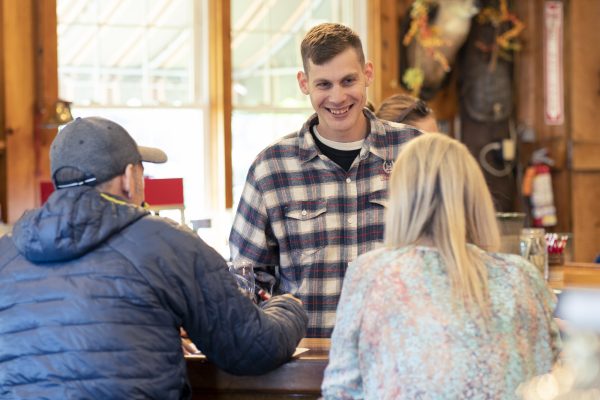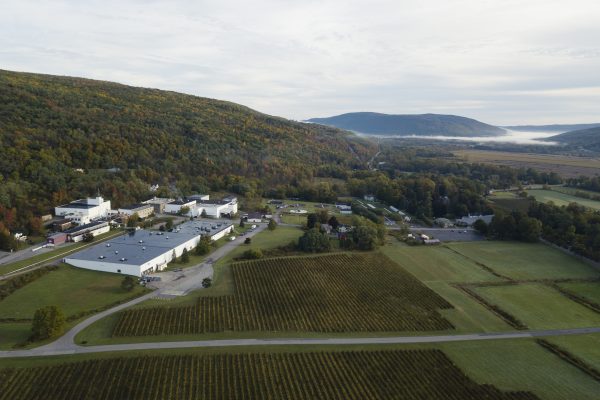One sweet harvest. Two siblings inherit a fun-loving family winery and build on its poignant legacy.
Rich soil. Deep water. The sweet air of autumn’s harvest. Winemakers who build their lives and livelihoods in New York’s Finger Lakes region know something about deep history because it permeates the land they work each day. Carved by glaciers thousands of years ago, the soft hills and deep lakes form an ideal climate for growing grapes. And one of the oldest farms in the region is Hazlitt 1852 Vineyards, now in its sixth generation as a family business.

Today, that business is jointly owned by siblings Doug Hazlitt and Leigh Hazlitt Triner, along with their spouses, Cheryl and Greg, respectively.
“My brother and I work on everything and have different areas of expertise,” Leigh says. “I work on HR, finance, retail, and interpersonal relations. Doug focuses on the vineyard, manufacturing, and wholesale.”
Doug and Leigh inherited the winery from their parents, Jerry and Elaine Hazlitt—the first generation in the family to introduce winemaking after more than a century of farming these hills. When Jerry and Elaine came along, Hazlitt had been in the business of growing a range of orchard fruits and grapes, which were sold to other companies for juice. But in the mid-1970s, the fruit business in New York State fell on hard times. It was the passage of the New York Farm Winery Act of 1976 that opened the doors to grape growers in New York to establish wineries and sell directly to the public. That legislation proved to be a catalyst that has turned the Finger Lakes region—and the Hazlitt winery—into industry powerhouses.

Jerry Hazlitt took advantage of the new legal landscape by splitting the farm between him and his brother, Jimmy. In 1985, Jerry opened both a winery and tasting room, having already planted many vineyards. Today, Hazlitt produces up to 1.5 million gallons of wine annually—and ships to 30 states around the country.
“We were one of the smallest wineries in the state, and now we’re one of the largest,” Leigh says.
But that growth might not have been possible if the family hadn’t been well prepared for the complex considerations that come with a generational succession plan. When parents pass on their business to offspring, it can bring up a variety of tough issues. Conflicts arise. Unexpected expenses and liabilities appear. And to navigate it all, the family turned to Woods Oviatt Gilman.
A long and wide-ranging relationship begins.
In 2002, as Jerry fell into poor health, it gave Doug and Leigh pause. It prompted the siblings to start thinking about how to prepare to transfer the business successfully.
“My dad got sick, and we got thinking about estate planning, and our attorney at the time told us we were fine. But it turned out we weren’t fine,” Leigh says. “We found out just in time. Then a friend recommended Woods Oviatt Gilman—and they basically came to our rescue.”
Woods Oviatt Gilman partner Tom Gilman worked with the family to craft an estate plan.
“Tom was our first point of contact, and he came on board and helped us out in a real hurry when we needed it most,” Leigh says. “And then continued the estate planning after our dad passed. Mom passed in 2010, so we had another eight years in between to figure out the rest of the estate plan.”
“When my dad passed away, it went to my mother,” Doug says. “And the real tax implications took place when she passed away. Woods Oviatt helped us an awful lot to make sure that when my mom passed, it could go to Leigh and me with minimal tax implications. They did an amazing job preparing us for that.”
Leigh notes that Woods Oviatt Gilman likely saved the family up to $300,000 through wise estate planning.
Elaine Hazlitt lived long enough to see her children do great things with her family’s legacy—all the while knowing the business would transfer to them smoothly. And the firm helped preserve something invaluable along the way: the bonds of family.
“Any time you’re dealing with a family business, there’s a family dynamic, personalities,” says Woods Oviatt Gilman attorney John Liebschutz. “We keep them focused on making decisions based on what’s best for the business, not what’s best for a single family member.”
New era, bigger needs.
While some things haven’t changed at Hazlitt—the down-to-earth, rustic tasting room where popcorn and friendly banter are favored over classical music and crackers—the business has changed in some extraordinary ways.

“In the interim between Jerry and Elaine’s death, the winery experienced rapid growth,” Tom says. “So, they had greater and greater legal needs and gravitated more toward using our legal services.”
Perhaps the most remarkable example: The family’s ambitious acquisition of a vast winemaking facility catapulted them into the status as producers of New York’s most popular home-state wine. In 2011, the Hazlitts purchased the former Widmer Wine Cellars complex in Naples, NY, adding dozens more acres in vineyards and more than three million gallons of capacity to their operation. And it was no small task to close the deal. The Woods Oviatt Gilman team brought all of their resources to bear to help make it happen.

“It had a lot of moving parts to it, both regulatory and real estate,” John says. “Our law firm had the real estate people. We had the businesspeople. We had the regulatory ability to handle all the issues that would come up. And we had the bandwidth to work with the family’s lenders and local folks in Naples and Ontario County to make sure that this business could remain a viable business in Ontario County.”
But acquisitions are not the only area of expertise the Hazlitts call upon the firm to help them with. Other practice areas they’ve relied on include support navigating the intricacies of an alcohol-related enterprise, such as complying with the State Liquor Authority and the Tax and Trade Bureau, as well as licensing matters. Then there’s human resources considerations.
“We now have nearly 80 employees that we need to pay attention to,” says Doug. “Woods Oviatt has a great person in their HR department that we go to for help all the time.”
“They helped us devise a really foolproof employee handbook,” adds Leigh. “They made sure the handbook was working for us and not against us.”
1852: A good year for grapes—and lawyers.
The Hazlitt family has mastered the Art of Winemaking, just like Woods Oviatt Gilman has mastered the Art of Representing People. And in both cases, they’ve been practicing the Art of Longevity since 1852.
“The Hazlitt family began farming the land in 1852,” says Tom, “and the first lawyer to whom we can trace our roots at Woods Oviatt Gilman was a Rochester lawyer who opened his law practice in Rochester in 1852. So, by coincidence, we have the same starting year.”
With roots that reach so deep into the region’s soil—and history—it’s a comfort for these siblings to know they’ve honored their parents’ legacy so well.
“We’ve come a long way and I think my parents would be proud of us,” Doug says.
A fitting toast to generations still to come.



